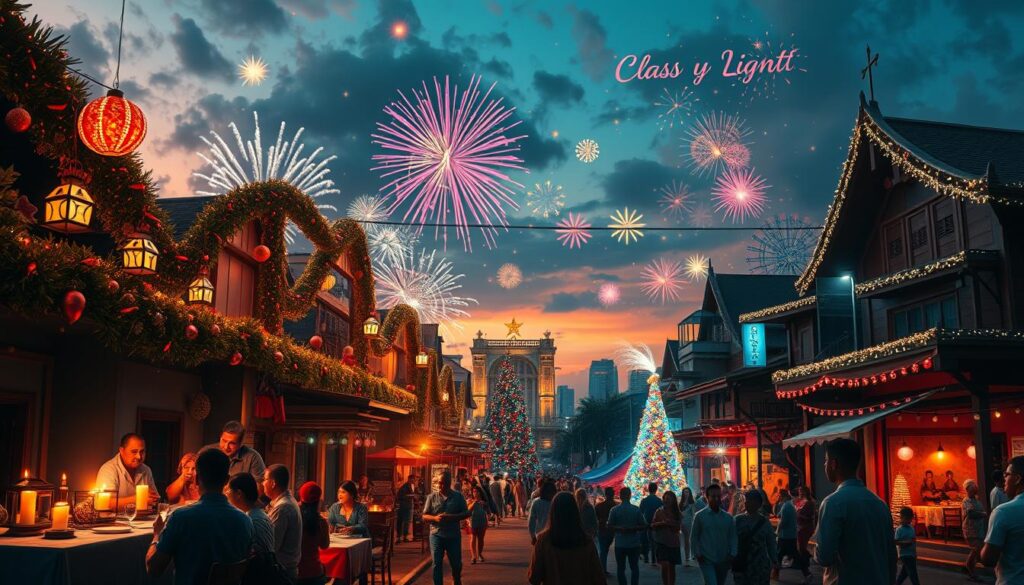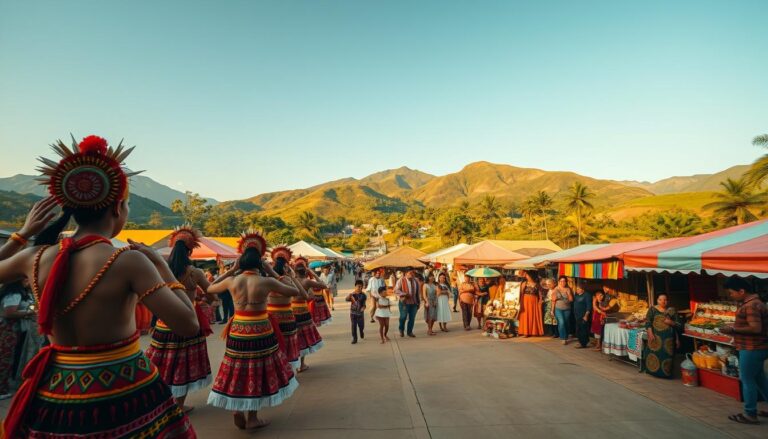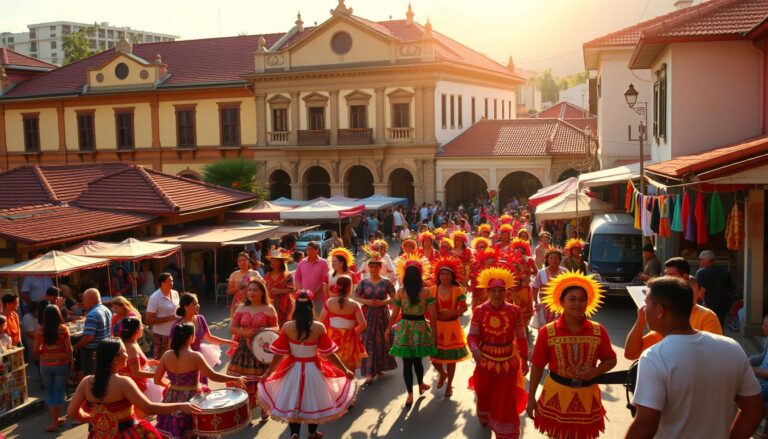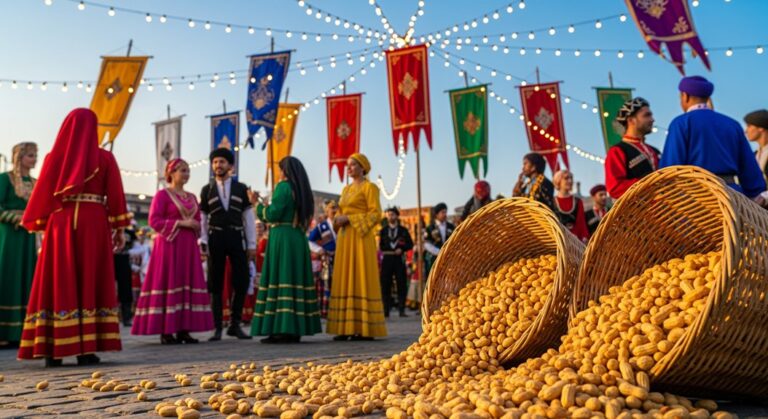Philippine Christmas Traditions: A Season of Joy

Ever wondered why the Philippines has the longest Christmas celebration? It starts in September and ends in January. This festive time brings joy to both locals and visitors. The Filipino Christmas, or “Pasko,” is a mix of religious events, family time, and community activities.
Exploring Philippine Christmas traditions reveals a world of special customs. Homes are lit up with Parol lanterns, and the smell of traditional foods fills the air. These traditions show the warmth and joy of Filipino hospitality.
Christmas in the Philippines is deeply connected to the country’s history and faith. With 90% of Filipinos being Christian, the holiday honors Jesus’ birth. At the same time, it celebrates unique cultural traditions. This blend of faith and culture makes the festive atmosphere unlike any other.
Key Takeaways
- The Philippines boasts the world’s longest Christmas celebration
- Pasko blends religious observances with cultural traditions
- 90% of Filipinos are Christian, influencing holiday customs
- Parol lanterns are symbolic decorations during the season
- Filipino Christmas traditions strengthen family and community bonds
The World’s Longest Christmas Celebration
The Filipino Christmas season is truly unique and lasts a long time. It starts as early as September, beginning the ‘Ber months’ in the Philippines. This four-month celebration shows the country’s love for Christmas and coming together as a community.
September Marks the Start of “Ber” Months
When September arrives, you’ll hear Christmas tunes on the radio and see decorations everywhere. The ‘Ber months’ – September, October, November, and December – kick off the holiday fun. This early start lets Filipinos enjoy the festive mood for a longer time.
Extending Until the Feast of Three Kings
The Filipino Christmas season doesn’t stop on December 25th. It goes on until the Feast of the Three Kings on January 6th. This long celebration gives families plenty of time to get together. Many travel to their hometowns to spend quality time with their loved ones.
Economic Impact of Extended Celebrations
The long Christmas season really helps the Philippine economy. Places like Pampanga, about 80 km north of Manila, see more job opportunities. Known for its food and lanterns, Pampanga starts preparing for the Giant Lantern Festival in July. This long celebration boosts spending on decorations, gifts, and festive items, helping many communities financially.
| Christmas Season Factor | Impact |
|---|---|
| Duration | 4 months (September to January) |
| Economic Boost | Increased spending on decorations, gifts, food |
| Cultural Significance | Family reunions, traditional delicacies, lantern festivals |
The Religious Significance of Filipino Christmas
Filipino Christmas holds a special place in many hearts. It’s a key Christian holiday in the Philippines, showing the nation’s deep faith. With 80% of Filipinos being Christians, mostly Catholics, the country is Asia’s Christian heartland.
The Christmas season in the Philippines is a mix of Western and native traditions. It starts with Advent and goes until the Feast of Three Kings in January. This long celebration is filled with spiritual experiences and community bonding.
One of the most loved Filipino Christmas traditions is Simbang Gabi. It’s a series of nine dawn Masses. Catholics believe going to all nine services brings special blessings. This shows the dedication of Filipino worshippers to their faith during the holiday season.
“Christmas in the Philippines is a time when faith, family, and festivity come together in perfect harmony.”
The religious side of Filipino Christmas is seen in many customs:
- Setting up Nativity scenes (Belen) in homes and public spaces
- Singing traditional Christmas carols with religious themes
- Participating in church services and processions
- Practicing acts of charity and giving
| Christian Holiday | Date | Significance |
|---|---|---|
| Simbang Gabi | Dec 16-24 | Nine-day novena of dawn Masses |
| Noche Buena | Dec 24 | Christmas Eve feast after Midnight Mass |
| Christmas Day | Dec 25 | Celebration of Christ’s birth |
| Feast of Three Kings | Jan 2-8 | Marks end of Christmas season |
These Christian holidays in the Philippines make the festive atmosphere rich with spiritual meaning. They remind Filipinos of Christmas’s true essence – the birth of Jesus Christ and the values of love, hope, and generosity.
Simbang Gabi: The Nine Dawn Masses
Simbang Gabi, also known as Misa de Gallo, is a beloved Filipino Christmas tradition. It starts on December 16 and ends on Christmas Eve. This tradition began in 1669 during Spanish colonial times and is deeply rooted in Filipino culture.
Origins and Cultural Importance
Filipino farmers and fishers first participated in Simbang Gabi. They went to dawn Masses before work. Now, these masses are a big part of Filipino culture, uniting communities in prayer and joy.
Community Gathering and Prayer
Simbang Gabi Masses start between 3:00 a.m. and 5:00 a.m. Some parishes have early celebrations from December 15 to 23. These events help keep Filipino traditions alive, even in the United States.
Beliefs and Blessings
Many believe that finishing all nine masses can lead to a special wish coming true. This tradition honors the Blessed Virgin Mary, with white being the official color. After Mass, people enjoy Filipino treats like bibingka, puto bumbong, and ginger tea.
| Simbang Gabi Tradition | Details |
|---|---|
| Duration | 9 days (December 16-24) |
| Mass Time | 3:00 a.m. – 5:00 a.m. |
| Liturgical Color | White |
| Traditional Foods | Bibingka, Puto Bumbong, Ginger Tea |
Philippine Christmas Traditions Through the Ages

Filipino Christmas history is a mix of old customs, Spanish influence, and new traditions. This blend makes Christmas in the Philippines special and different from anywhere else.
Did you know Christmas in the Philippines starts on September 1st and goes until early January? This long celebration shows how much Filipinos love Christmas, making it the longest in the world.
Simbang Gabi is a big tradition. It’s nine dawn masses starting on December 16th. This tradition comes from Spanish colonial times and is still important today.
“Christmas in the Philippines is a time when families come together, no matter how far apart they may be.”
Family is key during Christmas in the Philippines. With big families, Christmas is a lively time. Many overseas workers return home, bringing gifts and joy.
Christmas decorations in Filipino homes show the joy of the season. You’ll see big Christmas trees, bold ornaments, and the parol – a star-shaped lantern.
The Noche Buena feast on Christmas Eve is all about food and family. Traditional dishes like lechon and fruit salad are shared in big gatherings.
As Christmas traditions in the Philippines change, they keep their cultural value. They adapt to today’s world, making Christmas a special and joyful time for everyone.
Parol: The Iconic Filipino Christmas Lantern
The parol is a key part of Filipino Christmas traditions. These star-shaped lanterns brighten up homes and streets in the Philippines. They create a magical feel during the holiday season.
You’ll see parols on windows, trees, and in public areas. They add to the festive mood.
Symbolism of the Star of Bethlehem
Parols symbolize the Star of Bethlehem, guiding the Three Wise Men to Jesus. This makes parols more than decorations. They are symbols of faith and hope for many Filipinos.
Evolution of Parol Making
Parol making has a long history. At first, they were simple creations from bamboo and Japanese paper. Over time, the designs changed:
- Spanish colonial period: Rectangular or oblong shapes
- American colonial period: Adoption of the five-pointed star shape
- 1940s: Introduction of battery-operated parols with incandescent bulbs
- 1957: Invention of parols with rotor systems
Modern Designs and Materials
Today, parols show amazing creativity and innovation. Artisans use materials like plastic, metal, and capiz shells. Designs range from simple to complex, with some having programmable LED lights.
| Era | Material | Design Feature |
|---|---|---|
| Traditional | Bamboo and paper | Simple star shape |
| Mid-20th century | Metal and plastic | Electric lights |
| Modern | Capiz shells, LEDs | Programmable displays |
The parol is a lasting symbol of Filipino Christmas spirit. It combines tradition with modern touches. Whether simple or elaborate, these lanterns light up the holiday season with their beauty and warmth.
Traditional Christmas Delicacies
Filipino Christmas food is a feast for the senses. The holiday season brings a spread of mouthwatering dishes. These dishes warm hearts and fill bellies.
Puto Bumbong and Bibingka are beloved treats. Puto Bumbong is a purple rice cake steamed in bamboo tubes. It offers a unique texture and flavor. Bibingka, cooked in banana leaves, fills the air with a sweet aroma.
These treats are often sold outside churches during Simbang Gabi, the nine-day dawn masses.
The Christmas feast isn’t complete without Lechon, a whole roasted pig with crispy skin. Hamon, a sweet Christmas ham, is another staple on Filipino tables. For those with a sweet tooth, Polvoron, Yema, and Pastillas are must-try confections.
| Dish | Description | Occasion |
|---|---|---|
| Lechon | Whole roasted pig | Noche Buena |
| Puto Bumbong | Purple rice cake | Simbang Gabi |
| Bibingka | Rice cake in banana leaves | Simbang Gabi |
| Hamon | Sweet Christmas ham | Noche Buena |
| Polvoron | Powdered milk candy | Dessert |
These dishes do more than satisfy hunger. They bring families together, creating memories that last long after the season ends. The preparation and sharing of these foods strengthen bonds and keep traditions alive. This makes Filipino Christmas celebrations truly special.
Noche Buena: The Grand Christmas Eve Feast
Noche Buena is the highlight of Filipino Christmas Eve. It’s a time when families come together for a midnight feast. They share food, laughter, and joy.
Essential Noche Buena Dishes
The star of Noche Buena is the roasted pig, or lechon. Families enjoy many dishes that show off Filipino cooking. Here’s a look at what’s on a typical Noche Buena table:
| Dish | Description |
|---|---|
| Lechon | Whole roasted pig |
| Queso de Bola | Edam cheese ball |
| Hamonado | Sweet pineapple-glazed ham |
| Sotanghon Soup | Glass noodle soup |
| Dinuguan | Savory pork blood stew |
Family Gathering Traditions
Noche Buena is more than food; it’s about family. Families often fast during the day, waiting for the feast. Some even pray for nine days before the celebration.
Midnight Celebrations
When midnight hits, the fun starts. Families share stories, exchange gifts, and enjoy each other’s company. Some even celebrate online, connecting with family far away.
Noche Buena is a key part of Filipino culture. It shows the joy and warmth of Christmas. Whether in the Philippines or elsewhere, it keeps the Christmas spirit alive.
Filipino Christmas Music and Caroling

Christmas in the Philippines is filled with joy through music. Filipino Christmas carols fill the air, creating a festive atmosphere. The holiday music scene in the Philippines is rich and diverse, blending traditional songs with modern favorites.
Street caroling is a beloved tradition. Children and adults alike go door-to-door, singing cheerful tunes. They often use creative instruments, like tambourines made from bottle caps. This practice spreads holiday cheer and helps those in need, as carolers receive small gifts or money.
“Christmas in Our Hearts” by Jose Mari Chan is a standout in Filipino Christmas music. When it plays on the radio in September, Filipinos know the holiday season has begun.
“Christmas in Our Hearts is not just a song, it’s a signal that the most wonderful time of the year has arrived in the Philippines.”
Traditional carols hold a special place in Filipino hearts. Songs like “Ang Pasko ay Sumapit” and “Sa Maybahay ang Aming Bati” are sung with gusto. These tunes blend seamlessly with international Christmas hits, creating a unique holiday soundscape.
| Popular Filipino Christmas Songs | Artist | Year Released |
|---|---|---|
| Christmas in Our Hearts | Jose Mari Chan | 1990 |
| Ang Pasko ay Sumapit | Traditional | Unknown |
| Sa Maybahay ang Aming Bati | Traditional | Unknown |
| Pasko Na Sinta Ko | Gary Valenciano | 1985 |
The spirit of Christmas truly comes alive through music in the Philippines. From street caroling to radio hits, holiday music weaves through every aspect of the Filipino Christmas experience.
The Role of Ninongs and Ninangs in Christmas
Filipino godparents, known as Ninong and Ninang, are key in Christmas. They do more than just give gifts. They help shape family bonds and keep cultural traditions alive.
Responsibilities of Godparents
Ninongs and Ninangs are more than just gift-givers. They act as role models and guides. At Christmas, they’re vital in family gatherings and support.
Gift-Giving Traditions
Gift-giving is a big part of the Ninong and Ninang tradition. They give “Aguinaldo” to their godchildren, which can be money or presents. Today, they also use e-greetings and digital payments for ease.
| Traditional Gifts | Modern Gifts |
|---|---|
| Cash in envelopes | Digital money transfers |
| Toys and clothes | Gift cards |
| Food items | Online shopping vouchers |
Strengthening Family Bonds
Ninong and Ninang roles go beyond blood ties. They build a network of support for children. At Christmas, these bonds grow stronger through meals, gifts, and time together.
“Being a Ninong or Ninang is about creating lasting memories and guiding our godchildren through life’s journey, not just giving gifts during Christmas.”
While Christmas gifts are important, the true value of Ninong and Ninang lies in their lifelong commitment. They care for their godchildren’s well-being and growth.
Christmas Markets and Shopping Traditions
The Filipino Christmas markets start buzzing with excitement in September. Holiday shopping in the Philippines begins early, making it one of the longest Christmas celebrations globally. Traditional bazaars and modern malls offer a unique shopping experience during the season.
In Manila, the Noel Bazaar lasts for 48 days, filled with gift options. The World Bazaar Festival and Greenhills Night Market are also must-visit spots. These markets feature local crafts, decorations, and tasty treats.
The Kultura Christmas Market offers a special shopping experience. You can find unique gifts like perfumes, scented candles, and bamboo coffee mugs. These items celebrate Filipino craftsmanship and make thoughtful presents.
“Shopping for Christmas in the Philippines is not just about buying gifts; it’s about embracing the joy of the season.”
As you wander through the markets, you’ll see stunning Christmas displays. Parol lanterns and festive decorations light up the stalls. The smell of puto bumbong and bibingka, traditional treats, fills the air.
Holiday shopping in the Philippines is more than just buying gifts. It’s common to buy presents for godchildren and exchange gifts with friends or coworkers. So, get your shopping list ready and enjoy the festive spirit of Filipino Christmas markets!
Decorating Filipino Homes for Christmas
Filipino Christmas decorations turn homes into festive wonderlands. The holiday season starts as early as September. Families decorate their homes with vibrant decor, mixing traditional and modern elements.
Traditional Ornaments
Parols, star-shaped lanterns, are key in Filipino Christmas decorations. They light up neighborhoods from windows and balconies. The Belen, a nativity scene, is also a big part of Filipino homes. It holds deep religious meaning and is often passed down through generations.
Belen Setup
Setting up the Belen is a beloved tradition. It shows the birth of Jesus with figurines of Mary, Joseph, and animals. Families add local touches, making each Belen unique and personal.
Modern Christmas Decor Trends
Modern trends are also popular in Filipino homes. Christmas trees with colorful ornaments and lights are common. Families choose different color schemes each year.
Tabletop trees are great for small spaces. They add a festive touch without taking up much room.
The Filipino love for Christmas is seen in their light displays. Homes and streets are decorated with lights. Neighbors compete to make the brightest displays, adding to the festive spirit. This mix of old and new captures the joy and warmth of Christmas.
Christmas Eve Church Services and Traditions

Christmas Eve in the Philippines lights up churches across the nation. As night falls, families gather for the Filipino Christmas Eve mass, or Misa de Gallo. This tradition ends Simbang Gabi, a nine-day series of dawn masses.
The Misa de Gallo, held at midnight, is a key part of Filipino traditions. Churches are filled with worshippers, singing hymns of joy. Families attend together, strengthening bonds and making memories.
In some places, you might see the Panunuluyan. It’s a reenactment of Mary and Joseph’s search for shelter. It adds a special touch to the Christmas Eve experience.
After mass, families rush home for Noche Buena, a midnight feast. This mix of religious and festive celebrations shows the true spirit of Filipino Christmas. It’s a time when faith, family, and food unite.
“Christmas Eve mass is like a warm embrace from God. It fills our hearts with hope and love for the coming year.”
These traditions show the strong faith of Filipinos. With over 86 million Christians, the Philippines has the largest Christian population in Southeast Asia. During the holidays, churches become symbols of light and love.
Community Celebrations and Street Festivals
The Philippines shines with Filipino Christmas festivals during the holiday season. Street parades and community events turn cities into magical wonderlands. You’ll be swept into a four-month-long celebration starting in September and ending in January.
The Giant Lantern Festival in San Fernando, Pampanga, is a highlight. It lights up the night with stunning parol designs in a rainbow of colors. It’s a sight you can’t miss during the festive season.
Cities across the country host vibrant street parades with their own special touches. Baguio City, known as the “Summer Capital,” offers a cool holiday vibe with pine trees and lights. Cebu’s Sinulog Festival is famous for its lively parades and street dancing.
These events are more than just fun. They unite communities, keeping cultural heritage alive. Many have competitions for the best decorations or performances, encouraging locals to show their creativity.
| City | Festival | Main Attraction |
|---|---|---|
| San Fernando | Giant Lantern Festival | Elaborate parol designs |
| Baguio | Christmas in Baguio | Pine trees and festive lights |
| Cebu | Sinulog Festival | Vibrant parades and street dancing |
| Davao | Kadayawan Festival | Illuminated flower floats |
Whether you’re a local or a tourist, these festive gatherings are warm and joyful. From dawn masses to Noche Buena feasts, you’ll feel the true spirit of Filipino Christmas.
Local Christmas Customs Across Different Regions
The Philippines is a mosaic of Christmas traditions. From Luzon to Visayas and Mindanao, each area brings its own twist to the holiday. These customs reflect the country’s rich cultural diversity.
Luzon Christmas Traditions
In Luzon, the Giant Lantern Festival in Pampanga dazzles with stunning lanterns. You’ll see “gigantes” in colorful costumes parading through towns. Baguio City’s Panagbenga Festival celebrates with vibrant flower displays.
Visayan Christmas Practices
The Visayas region adds its own flair to Christmas. Cebuanos celebrate the Santo Niño with the Sinulog Festival. In Bohol, kids climb coconut trees in the “Bonok-Bonok” tradition.
Mindanao Holiday Celebrations
Mindanao mixes Christian traditions with local customs. Marawi City’s Lanao Food Festival showcases Maranao cuisine. In Davao, the Kadayawan Festival features indigenous dances and crafts, adding to the holiday cheer.





